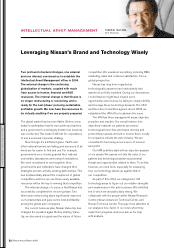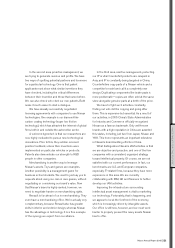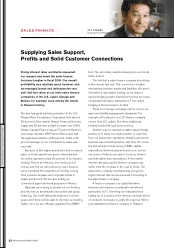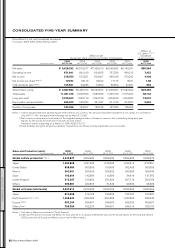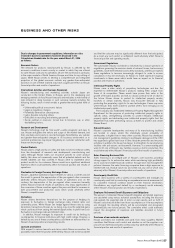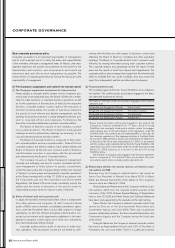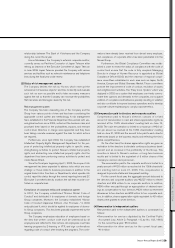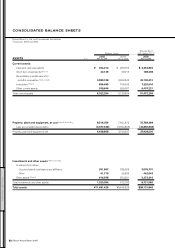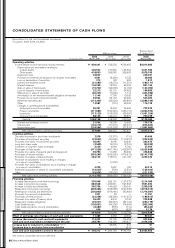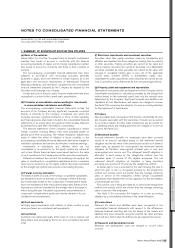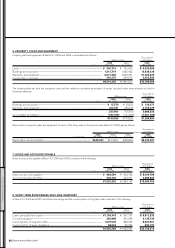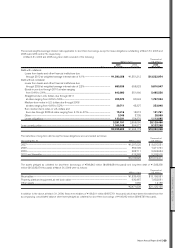Nissan 2006 Annual Report Download - page 61
Download and view the complete annual report
Please find page 61 of the 2006 Nissan annual report below. You can navigate through the pages in the report by either clicking on the pages listed below, or by using the keyword search tool below to find specific information within the annual report.
relationship between The Bank of Yokohama and the Company
during the current fiscal year.
Haruo Murakami, the Company’s external corporate auditor,
currently serves as Part-time Counselor of Japan Telecom after
retiring as chairman of the Executive Committee of Japan Telecom
in June 2006. Japan Telecom provided the Company with various
services and facilities such as network maintenance and telephone
lines during the fiscal year under review.
(2) Status of risk management system
The Company defines the risk as “factors which interrupt the
achievement of business objects,” and tries to identify and evaluate
such risk as soon as possible and to take necessary measures
against the risk so that the Company can minimize the probabilities
that risk arises and damages caused by the risk.
Risk management system
The Company has been evaluating risk of the Company and the
Group from various points of view and has been considering the
appropriate control system and methodology. A risk management
team established in the Financial Department has worked with sev-
eral global sections since 2004, sorted out the business risks, and
prioritized them based on the probabilities, impacts, and relevant
control level. Directors in charge were appointed and they have
been taking concrete measures against the risks for which actions
are required.
Furthermore, since April 2004, the Company has established
Intellectual Property Rights Management Department for the pur-
pose of protecting intellectual property rights in specific areas,
strengthening activities to protect Nissan’s intellectual property
rights, and abstracting new intellectual property rights. And the
department has been performing various activities to protect and
create Nissan Brand.
Since the fiscal year beginning April 1, 2005, the scope of risk
management has been expanded to address risks which are more
strategic or those relate to business processes in addition to the
original hazard risks. Functions or Departments, which operate risk
control, report the status through the normal reporting lines and EC
(Executive Committee) directly monitors the risk that must be con-
trolled on corporate level.
Compliance of corporate ethics and compliance system
In 2001, the Company established “Nissan Global Code of
Conduct” and distributed it to employees of domestic and foreign
Group companies. Moreover, the Company established “Nissan
Code of Conduct (Japanese Edition) ~Our Promises~” in 2004
and publicized it, which should be applied to employees of domes-
tic Group companies. This has been gradually implemented by the
Group companies.
The Company emphasizes education of employees based on
the idea that written conduct code must be understood by all
employees and reflected to their actions. All employees must take
learning programs by E-learning or VTR, and sign confirmations
regarding code of conduct after finishing the programs. The confir-
mations have already been received from almost every employee,
and compliance of corporate ethics has been penetrated into the
Nissan Group.
Furthermore, the Global Compliance Committee was estab-
lished in order to review the status of compliance with the code of
conduct and ensure that the code is fully complied. Managing
Director in charge of Human Resource is appointed as Global
Compliance Officer (GCO) and the chairman of regional compli-
ance committees established in each area such as Japan, North
America, Europe and Global Overseas Market. Those committees
promote the improvement of code of conduct, resolution of issues
and enlightenment activities. The “Easy Voice System,” which was
deployed in 2002 as a system that employees can freely commu-
nicate their opinions and demands to the companies, can acquaint
violation of compliance and behaviors possibly resulting in violation
and also contribute to improve business operations and to develop
corporate culture emphasizing to comply corporate ethics.
(3) Compensation paid to directors and corporate auditors
Compensation paid to Nissan’s directors consists of a fixed
amount of remuneration in cash and shares appreciation rights as
resolved at the 104th shareholders’ meeting held on June 19,
2003. The cash remuneration is limited to a maximum of ¥2.6 bil-
lion per annum as resolved at the 106th shareholders’ meeting
held on June 21, 2005 and the amount to be paid to each director
determined based on the business results and reflecting the firm’s
global competitiveness.
On the other hand, the shares appreciation rights are given as
motivation to the directors to stimulate continuous business devel-
opment and an increase in the profitability of the Group. This
incentive is linked to Nissan’s medium- or long-term business
results and is limited to the equivalent of 6 million shares of the
Company’s common stock per annum.
The remuneration paid to the corporate auditors is limited to a
yearly amount of ¥120 million as resolved at the 106th sharehold-
ers’ meeting held on June 21, 2005. This compensation is
designed to promote stable and transparent auditing.
For the current fiscal year, the aggregate amount disbursed to
the directors and corporate auditors was ¥2,527 million to eleven
directors and ¥86 million to six corporate auditors. In addition,
¥390 million was paid through an appropriation of retained earn-
ings as compensation to four directors, ¥624 million as retirement
allowances to two directors and ¥88 million to two corporate audi-
tors. In addition, shares appreciation rights equivalent to 4.8 million
shares were granted to seven directors.
(4) Remuneration to independent auditors
Remuneration paid to the independent auditors is summarized as
follows:
• Remuneration for services stipulated by the Certified Public
Accountant Law, Article 2, Paragraph 1 (Law No. 103, 1948)
for the current fiscal year: ¥510 million
• Remuneration for other services for the current fiscal year:
¥14 million
Nissan Annual Report 2005 59
FINANCIAL SECTION



